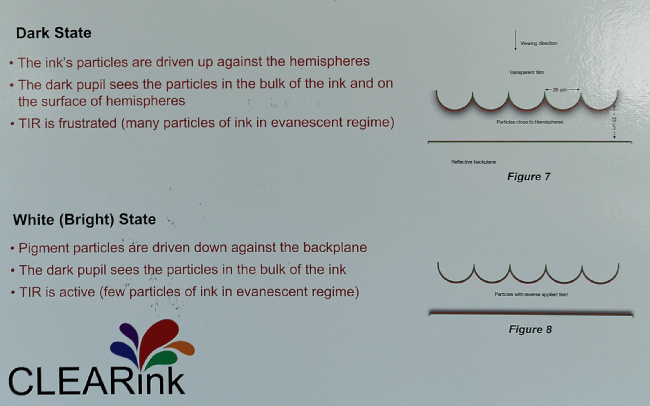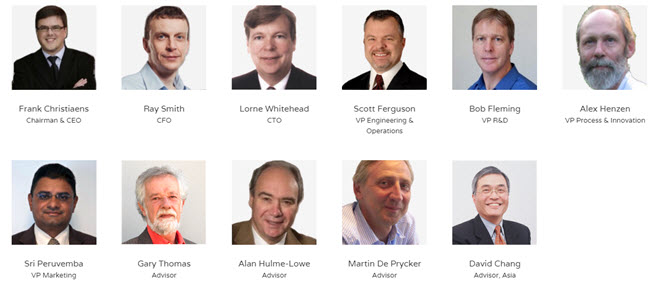Several weeks ago, Ken wrote a Display Daily on a start-up called ClearInk (CLEARink Brings New Wrinkle to Electrophoretic Displays). I was travelling at the time and, unusually, I didn’t edit it – the second best way to understand what a company is doing (the best is writing an article!). As a result, the company had not impinged on my consciousness, so it was with an open (some would say empty 🙂 ) mind that I met the firm with Ken at the end of SID in its suite, close to the convention centre. The company was not on the show floor as it was worried that its technology might be viewed negatively as it is a start up, with limited resources and its samples would be compared to companies that have had many years and many engineers to develop their technology. For the same reason, we were not able to take pictures. They, perhaps, should not have worried.
 Merck Showed this image of earlier versions of the ink in a paper presented at the 2015 SID.
Merck Showed this image of earlier versions of the ink in a paper presented at the 2015 SID.
Ken covered the technology in his Display Daily, but basically, it is an electrophoretic system. However, it works by reflecting, by TIR, most of the light (60%) that impinges on the display, and then using particles to disrupt the reflection. As a result, the company doesn’t have to move big (relatively) particles a long way through a fluid – it just has to move the particles from touching to not touching and we heard that the switch distance is around 0.5µm.
That means that it can operate at speeds that ‘classic’ EPDs such as those from E Ink and Sipix cannot reach. As a result of that, the company can operate at video rates. So, it has a very low power device that can operate at video rates – that’s interesting! We asked about bit depth and the company said that it can produce 16 grey levels, but, of course, as a very high resolution and high speed display, there will be opportunities to use time and space to modulate the reflection.

My first impression of the technology was of the brightness of the reflection, which was significantly better than competitive technologies, but with the ‘paper’ look that EPDs have. The materials it uses are developed in a partnership with Merck. (Again, Ken wrote about Merck’s new openness to partnerships). Often. a barrier for new display technologies is that they need special drivers, but the company told us that it uses ‘commercial’ driver chips. One of the advantages of the small distance that the particles move is that only a low voltage is needed – apparently around 5V. Because the particles are small, the resolution is basically limited by the resolution of the backplane. Building a backplane is not a trivial job for a start up, so up to now, the firm has taken off the shelf Kindle eReaders and stripped the display from the front, leaving the backplane and it has been able to make those samples look surprisingly good!
The company sees no problem in manufacturing – the process is very similar to existing LCD technologies, which could make it attractive for companies that are looking to move away from LCD. It can be made using known production technologies, such as one drop fill (ODF)
Colour is achieved by adding a colour filter and the firm had made a colour filter using an inkjet printer – a pretty crude approach, but which worked surprisingly well. Of course, if you could just reflect specific colours of light, you wouldn’t need a filter, but the company thinks it will take around 18 months to develop colour. Flexible substrates are not a problem for the technology.
Early applications are expected to be electronic shelf labels and wearables. As CEO, Frank Christiaens, pointed out, there is no obvious display technology for wearables. Flexible OLEDs are good, but still use more power than you want, meaning frequent re-charging.
 ClearInk has an impressive team
ClearInk has an impressive team
Christiaens, a veteran of the display business with Barco and others and in China. has built a very impressive team to promote his business and the company is looking to license its technology or work with manufacturers. Broadly, the business model is ‘ip exploitation’, but the company is very open on business models. It is looking for funding and for joint venture products. Christiaens told us that it has a first customer that is planning to come to market with a product in Q1 2017 and we assume that is Suzhou Jinfu of China, with whom Clearink announced a joint venture, just before SID.
Analyst Comment
I picked ClearInk out as one of my top four highlights of SID 2016. It’s hard to make a breakthrough technology, but from what I’ve seen, I think that ClearInk has a real chance of being a game changer. I worry a little about grey scales and colour for video, but it’s clear that the company has created something quite compelling with extremely limited resources and limited facilities. In that respect, it reminds me of Cambridge Display Technology when I first met that OLED pioneer company when it was not much more than a university project. If you care about wearable displays or ESLs, I strongly recommend you check these guys out!
The other companies that have promised this kind of performance – low power and video – have been the large MEMs companies (that Qualcomm bought) who found it just too difficult to make the displays with enough yield to be profitable and Liquavista, which is still in development with support from Amazon (and which, as Ken pointed out) now has a web page again. (BR)
This article was independently written and prepared, but was moved from behind the pay wall with sponsorship from the company

